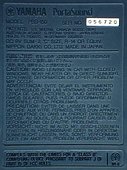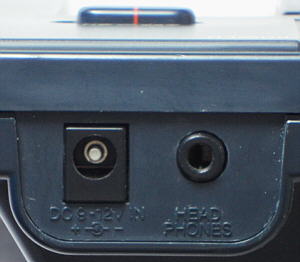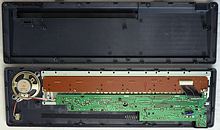This simple Yamaha PortaSound beginners keyboard from 1985(?) has only 4 rhythms and 5 sounds, but features an interesting programmable drum pattern ("custom drummer"). The instrument has 4 note polyphonic squarewave sounds and a few interesting electronic percussion.

| base & tom | = low & higher squarewave blips |
| snare | = shift register noise |
| open cymbal | = unique electronic metallic timbre (low- res waveform sample??, or 2 mixed squarewaves?) with truncated decay and audible end click. |
| closed cym. | = dto.' with shorter envelope |
| (old eBay photo of my specimen) |  |
 |
 |
 |
 |
The main voice sounds are made from squarewave with different pulse widths and the envelopes have audible zipper noise. The "violin" features a delayed vibrato (a feature that none of my many YM2163 no-name instruments has) and also the vibraphone has a vibrato. Unfortunately the accompaniment tends to drown the main voice because it is a bit too loud and has no own volume control.
The drum pattern programming works here different from the "custom drummer" of the MC-3 and rather resembles the Elta KE-6. You have to select one of the preset rhythms as a template and press the "program" button which makes an empty rhythm repeats in a loop while a closed cymbal goes as a metronome (which is not recorded). Then you can now add additional percussion in realtime with the rightmost 5 white keyboard keys. (The pattern length depends on the selected rhythm.) You can delete the current pattern by pressing "program" again. The programming mode can in a limited way also be abused as a realtime tekkno drum computer and unlike the Elta KE-6 you can even play keyboard(!) during this on the remaining keys (with or without accompaniment). The pattern resolution depends on the selected rhythm and is high enough to get bizarre and complex "tribal" drum loops out of it. After finishing programming (press "stop"), the user pattern can be played by pressing "play". (The accompaniment of the user pattern can not be changed afterward, because starting the pattern with a different rhythm switches the accompaniment back to the one of the rhythm it was recorded with.) When "play" is pressed without recording (or after deleting) a user pattern, the instrument turns rhythm off and switches the rightmost keys into drumpad mode. Interesting is that although sound selection of this instrument is in no way OBS, you can play on the keyboard with rhythm and accompaniment, then program (and delete) in realtime a new user pattern and switch back and forward between the user and the default rhythm pattern all without stopping the accompaniment.
The nicely programmed polyphonic demo melody (which is even advertised on the box and gladly labelled on the case "programmed music") ignores manual sound/ rhythm switch attempts and does not even respond on moving the tempo slider.
A similar looking beige toy instrument with animal and voice samples
was the 32 keys Yamaha PSS-110.
A competitive product to the Yamaha PSS-150 was likely the Casio
MT-36, which looks and sounds fairly similar.
| removal of these screws voids warranty... | ||
 |
||
|
|